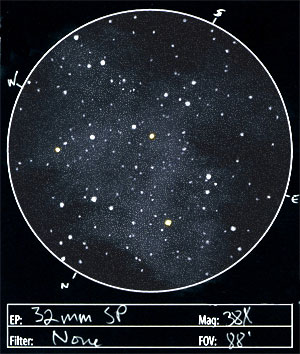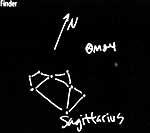
Observation Notes:
 M24 is a huge fog of stars. I couldn’t fit the whole thing in the view. A number of bright stars spattered the field with a mottled cloud of granular stars. Light pollution was too heavy to get very strong structure in the cloud. Open cluster NGC 6603 should be visible toward the northeast edge of my sketch, but I apparently didn’t notice it since I wasn’t searching for it.
M24 is a huge fog of stars. I couldn’t fit the whole thing in the view. A number of bright stars spattered the field with a mottled cloud of granular stars. Light pollution was too heavy to get very strong structure in the cloud. Open cluster NGC 6603 should be visible toward the northeast edge of my sketch, but I apparently didn’t notice it since I wasn’t searching for it.
When making the sketch above, I shaded in the star cloud smoothly. I added granularity/noise to the shaded area later in Adobe Photoshop. I wish there was a way I could create this effect reliably by hand at the eyepiece, but alas I’m not ready to use paint spatter techniques at the telescope.
Factoids:
M24 is not an actual star cluster, but is a portion of the inner reaches of the Milky way that is visible due to a relatively clear opening in the interstellar dust clouds that circulate through the arms of our galaxy. This fortunate window into the galaxy allows for the study of otherwise hidden reaches within the Milky Way. The region of M24 contains two significant dark nebulae (Barnard 92 and 93), emission nebulae (IC1283-1284), reflection nebulae (NGC 6589 and 6590), planetary nebula (NGC 6567), open clusters (Collinder 469, Markarian 38, NGC 6595, and NGC 6603).
M24 was discovered by Charles Messier in 1764.
| Subject | M24 |
| Classification | Milky Way Patch |
| Position* | Sagittarius [RA: 18:16:54 / Dec: -18:29:00] |
| Size* | 90.0′ |
| Brightness* | 4.6 |
| Date/Time | October 22, 2005 – 7:00 PM (October 23, 2005 – 02:00 UT) |
| Observing Loc. | Flagstaff, AZ – Home |
| Instrument | Orion SVP 6LT Reflector (150 mm dia./1200 mm F/L) |
| Eyepieces/Mag. | 32 mm (38X) |
| Conditions | Clear, calm |
| Seeing | 3/10 Pickering |
| Transparency | Mag 4.5 NELM (based on 36-Capricornus) |
| Sources | SEDS |
*Based on published data.